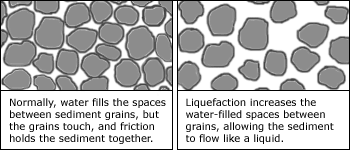Assuming the title is correct, and the part where the water is seen streaming out of the ground makes me think it is, this is a case of soil liquefaction.
This is common in ground that is saturated with water during earthquakes, and is one of the most common causes of major damage.
During normal condition sin saturated soils, the water sits between the dirt/rock particles and moves slowly through the ground.
When the soil is shaken by the earthquake, it increases the water pressure in the ground which effectively makes the gap between the soil particles bigger. This makes the soil more of a "fluid" and thus you not only see the funky moments in the video, but buildings have been known to "sink" into the soil.
A video showing this happening in the lab is
here
<iframe title="YouTube video player" width="480" height="390" src="http://www.youtube.com/embed/ngxG49Lf6co" frameborder="0" allowfullscreen></iframe>
And
here
<iframe title="YouTube video player" width="480" height="390" src="http://www.youtube.com/embed/sjdPVzQ0MBc" frameborder="0" allowfullscreen></iframe>
Think of it as nature's version of Coleco electric football, except the soil doesn't just move across the surface of the field but can move in all three dimensions.
You can also think of it as the vibration of the earth turns the wet soil into something more like quicksand. Not an exact analogy, but the effect is similar.
As Harrisonhits pointed out, reclaimed land from the sea or lakes is more prone to this because it tends to consist of small grain soil and be saturated with water, two things that are very prone to liquefaction.
As I recall, the biggest damage during the World Series earthquake in SF was in the marina district and was attributed to soil liquefaction, as well as the 1985 Mexico City earthquake. Both were in regions of reclaimed land from water. Mexico City was from the lakes not the ocean.







